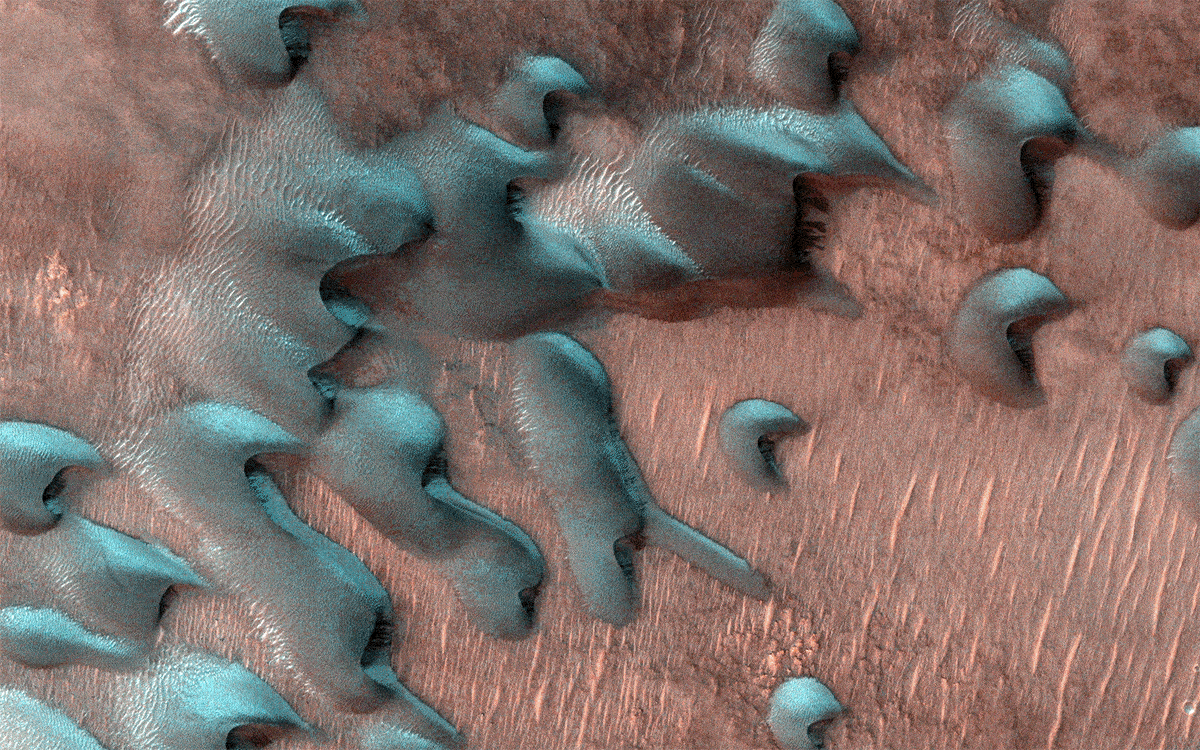Cube-shaped snow, icy landscapes, and frost are all part of the coldest season on the Red Planet.
When winter comes[{” attribute=””>Mars, the surface is transformed into a truly otherworldly holiday scene. Snow, ice, and frost accompany the season’s sub-zero temperatures. Some of the coldest of these occur at the planet’s poles, where it gets as low as minus 190 degrees Fahrenheit (minus 123 degrees Celsius).

The HiRISE camera aboard NASA’s Mars Reconnaissance Orbiter captured these images of sand dunes covered by frost just after winter solstice. The frost here is a mixture of carbon dioxide (dry) ice and water ice and will disappear in a few months when spring arrives. Credit: NASA/JPL-Caltech/University of Arizona
Cold as it is, don’t expect snow drifts worthy of the Rocky Mountains. No region of Mars gets more than a few feet of snow, most of which falls over extremely flat areas. And the Red Planet’s elliptical orbit means it takes many more months for winter to come around: a single Mars year is around two Earth years.
Snow falls, ice and frost form on Mars as well.[{” attribute=””>NASA’s spacecraft on and orbiting the Red Planet reveal the similarities to and differences from how we experience winter on Earth. Mars scientist Sylvain Piqueux of JPL explains in this video. Credit: NASA/JPL-Caltech
Still, the planet offers unique winter phenomena that scientists have been able to study, thanks to NASA’s robotic Mars explorers. Here are a few of the things they’ve discovered:
Two Kinds of Snow
Martian snow comes in two varieties: water ice and carbon dioxide, or dry ice. Because Martian air is so thin and the temperatures so cold, water-ice snow sublimates, or becomes a gas, before it even touches the ground. Dry-ice snow actually does reach the ground.
“Enough falls that you could snowshoe across it,” said Sylvain Piqueux, a Mars scientist at NASA’s Jet Propulsion Laboratory in Southern California whose research includes a variety of winter phenomena. “If you were looking for skiing, though, you’d have to go into a crater or cliffside, where snow could build up on a sloped surface.”

HiRISE captured these “megadunes,” also called barchans. Carbon dioxide frost and ice have formed over the dunes during the winter; as this starts to sublimate during spring, the darker-colored dune sand is revealed. Credit: NASA/JPL-Caltech/University of Arizona
How We Know It Snows
Snow occurs only at the coldest extremes of Mars: at the poles, under cloud cover, and at night. Cameras on orbiting spacecraft can’t see through those clouds, and surface missions can’t survive in the extreme cold. As a result, no images of falling snow have ever been captured. But scientists know it happens, thanks to a few special science instruments.
NASA’s Mars Reconnaissance Orbiter can peer through cloud cover using its Mars Climate Sounder instrument, which detects light in wavelengths imperceptible to the human eye. That ability has allowed scientists to detect carbon dioxide snow falling to the ground. And in 2008, NASA sent the Phoenix lander within 1,000 miles (about 1,600 kilometers) of Mars’ north pole, where it used a laser instrument to detect water-ice snow falling to the surface.
NASA scientists can measure the size and shape of the snow particle distribution, layer by layer, in the storm. The Global Precipitation Measurement Mission is an international satellite project that will provide the next generation of observations of worldwide rain and snow every three hours. Credit: NASA’s Goddard Space Flight Center/Ryan Fitzgibbons
ice cubes
Because of how water molecules are bound together when they freeze, snowflakes on Earth have six sides. The same principle applies to all crystals: the way the atoms organize themselves determines the shape of the crystal. In the case of carbon dioxide, the molecules in dry ice are always linked into four shapes when frozen.
“Because carbon dioxide ice has a symmetry of four, we know that the dry snowflakes will be cube-shaped,” Bicchio said. “Thanks to the Martian climate safer, we can say that these snowflakes will be smaller than the width of a human hair.”

The HiRISE camera captured this image of a crater rim in the middle of winter. A south-facing crater slope, which receives less sunlight, forms a patchy, bright frost, shown in blue in this enhanced-color image. Image credit: NASA/JPL-Caltech/University of Arizona
Jack Frost nibbles at your rover
Both water and carbon dioxide can form frost on Mars, and both types of frost appear more widely across the planet than snow. The Viking landers saw a water frost when they studied Mars in the 1970s, while NASA’s Odyssey orbiter saw Frost formation is observed and it sublimates away morning sun.

HiRISE captured this spring scene, when water ice frozen in the soil split the Earth into polygons. The transparent carbon dioxide ice allows sunlight to shine through and heat the gases that seep through the vents, shooting fans of darker material at the surface (shown blue in this enhanced color image). Image credit: NASA/JPL-Caltech/University of Arizona
The strange end of winter
Perhaps the most amazing discovery comes at the end of winter, when all the ice that has been created begins to “melt” and sublimate into the atmosphere. As it does so, this ice takes on strange, beautiful shapes that it reminded scientists of spidersAnd the Dalmatian spotsAnd the Fried eggsAnd the Swiss cheese.
This “melt” also causes geysers to erupt: the transparent ice allows sunlight to heat the gas beneath, and that gas eventually explodes, sending dust fans on the roof. Scientists have already begun studying these fans as a way to learn more about them In which direction are the Martian winds blowing?.

“Reader. Infuriatingly humble coffee enthusiast. Future teen idol. Tv nerd. Explorer. Organizer. Twitter aficionado. Evil music fanatic.”

